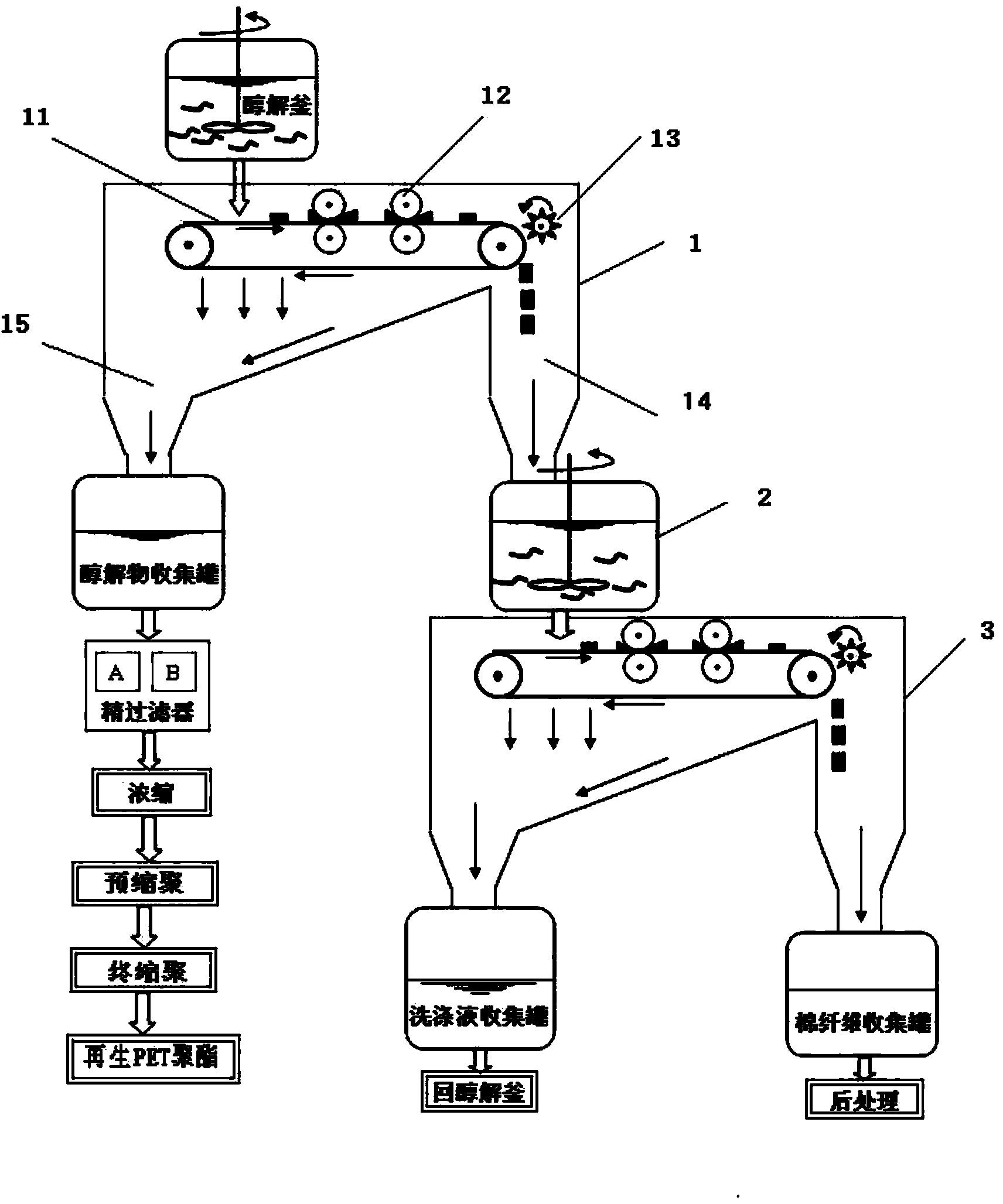Device and process for continuously separating and recycling waste polyester cotton textiles
A technology for separation and recovery of textiles, which is applied in the field of continuous separation and recovery of waste polyester-cotton textiles. It can solve the problems of continuous industrial production that cannot realize separation and recovery, and the inability to separate polyester and cotton components, and achieve continuous separation. , Guarantee the effect of clean production and high degree of engineering
- Summary
- Abstract
- Description
- Claims
- Application Information
AI Technical Summary
Problems solved by technology
Method used
Image
Examples
Embodiment 1
[0064] The polyester-cotton blended fabric containing 15% of cotton yarn is crushed into 4cm×4cm in size, transported to the alcoholysis kettle, and ethylene glycol 6 times the weight of the polyester-cotton fabric is added, and after alcoholysis at 240°C and 200kPa pressure for 5 hours, Separation through the polyester-cotton separation system, the obtained regenerated cotton is collected and reused after washing and drying. The breaking strength of the regenerated cotton yarn is 14.2cN / tex, and the breaking elongation is 15.5%. The polyester alcoholyzate obtained after separation enters the subsequent polymerization stage after fine filtration and concentration. The precondensation temperature is 278°C, the vacuum degree is 2kPa absolute pressure, the final polycondensation temperature is 285°C, and the vacuum degree is 120Pa absolute pressure. Regenerated PET polyester with a viscosity of 0.67 dl / g.
Embodiment 2
[0066] The polyester-cotton blended fabric containing 20% cotton yarn is crushed into 6cm×6cm size, transported to the alcoholysis kettle, adding ethylene glycol 5 times the weight of the polyester-cotton fabric, and after alcoholysis at 245°C and 300kPa pressure for 4 hours, Separation through the polyester-cotton separation system, the obtained regenerated cotton is collected and reused after washing and drying. The breaking strength of the regenerated cotton yarn is 15.2cN / tex, and the breaking elongation is 16.1%. The polyester alcoholyzate obtained after separation enters the subsequent polymerization stage after fine filtration and concentration. The precondensation temperature is 276°C, the vacuum degree is 1.8kPa absolute pressure, the final polycondensation temperature is 282°C, and the vacuum degree is 105Pa absolute pressure. Regenerated PET polyester with an intrinsic viscosity of 0.70 dl / g.
Embodiment 3
[0068] The polyester-cotton blended fabric containing 25% of cotton yarn is crushed into 8cm×8cm in size, then transported to the alcoholysis kettle, adding ethylene glycol 25 times the weight of the polyester-cotton fabric, and after alcoholysis at 200°C and 50kPa pressure for 7 hours, Separation through the polyester-cotton separation system, the obtained regenerated cotton is collected and reused after washing and drying. The breaking strength of the regenerated cotton yarn is 15.7cN / tex, and the breaking elongation is 16.3%. The polyester alcoholyzate obtained after separation enters the subsequent polymerization stage after fine filtration and concentration. The precondensation temperature is 279°C, the vacuum degree is 2kPa absolute pressure, the final polycondensation temperature is 268°C, and the vacuum degree is 102Pa absolute pressure. Regenerated PET polyester with a viscosity of 0.69 dl / g.
PUM
| Property | Measurement | Unit |
|---|---|---|
| Breaking strength | aaaaa | aaaaa |
| Intrinsic viscosity | aaaaa | aaaaa |
| Breaking strength | aaaaa | aaaaa |
Abstract
Description
Claims
Application Information
 Login to View More
Login to View More - R&D
- Intellectual Property
- Life Sciences
- Materials
- Tech Scout
- Unparalleled Data Quality
- Higher Quality Content
- 60% Fewer Hallucinations
Browse by: Latest US Patents, China's latest patents, Technical Efficacy Thesaurus, Application Domain, Technology Topic, Popular Technical Reports.
© 2025 PatSnap. All rights reserved.Legal|Privacy policy|Modern Slavery Act Transparency Statement|Sitemap|About US| Contact US: help@patsnap.com

